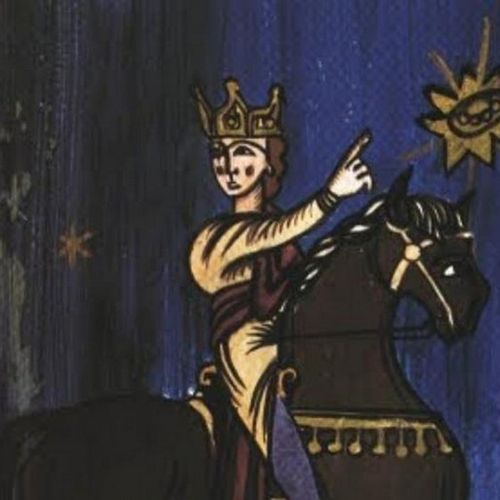
| Added | Wed, 28/09/2022 |
| Источники | |
| Феномены | |
| Версии |
Значительное число представлений о паранормальном, пришедших из областии искусства, основано на заблуждениях. Мы уже публиковали на эту тему небольшую статью, в которой рассматривали некоторые из причин возникновения этих заблуждений (ошибки переводов, технологические особенности), а также касались темы специфики различных художественных стилей.
Искусство заблуждаться
Часто мистические истории обнаруживаются в музеях, но не в виде призраков, а в виде легенд, связанных с заблуждениями о произведениях искусства.
В данной статье мы подробнее остановимся как раз на особенностях стилей рисования, незнание которых часто становятся причиной ошибок интерпретации. В частности, авторы уфологических статей, "обнаруживающие НЛО на старых картинах", иногда просто не знают о значении или контексте применения изображенных на них предметов, которые они принимают за космические корабли пришельцев.
Мы нашли несколько статей, описывающих подобные заблуждения и их причины. Ссылки на сами статьи мы указали в списке источников, здесь же мы приведем их основные мысли. Для удобства восприятия информация о каждой из рассматриваемых картин приведена в галерее.
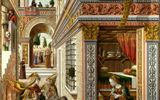
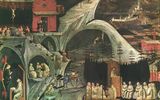
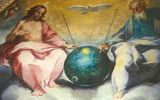
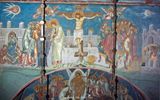
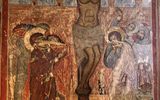
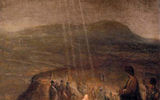
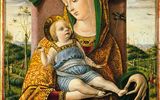
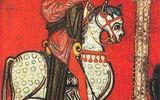
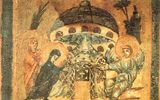
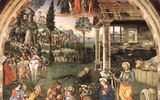
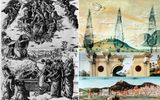
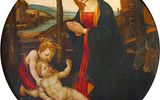
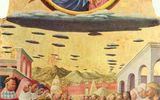




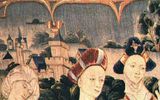
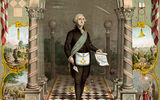
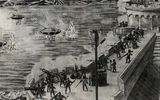

Annunciation with Saint Emidio (Annunciazione con sant'Emidio) is an altarpiece by the Italian painter Carlo Crivelli.
Ufologists usually find it strange that a ray that descends from the sky and hits the Madonna. They claim that this ray comes from an unidentified flying disc-shaped object that is located among the clouds.
In fact, this is a fairly standard designation for this plot. The original image shows that the object in the sky from which the rays come is formed by a circle of clouds, inside of which there are two circles of little angels. This is a very common image of the deity, which can be seen in many works of sacred art (for example, The Annunciation, Fra Beato Angelico, 1430). A ray from the sky is a symbol of the good news, and it can often be found in other paintings with a similar plot:
.. The dove of the Holy Spirit usually descends along a ray of light that ends on Mary's head or chest. God the Father may appear in heaven, the source of this light. The image as a whole represents the conception of Jesus in the womb of the Madonna, or rather his incarnation through the Holy Spirit descended from heaven. (...) Even the rays of light penetrating through the window glass are a symbol of virginity. (...) A walled garden, the so-called Hortus Conclusus, and/or a tower, both symbols of Mary's chastity, can also find a place in the composition.
J. Hall "Dictionary of plots and symbols in Art".

Paolo Uccello's painting "Scenes of Hermit Life", also known as "La Tebaida" (La Tebaide).
According to ufological hypotheses, the red object in the cave in the center, to the right of the cross, may be a flying saucer. However, this item is too small, and is actually a cardinal's hat. The fact that this is exactly her is clearly seen in the versions of the same scene by Pietro Vannucci, Albrecht Durer and Albrecht Boots.
"In one of the most common iconographic modules, Jerome in the desert hits himself in the chest with a stone, kneeling before the crucifixion or immersed in reading the Holy Scriptures to discover the sequence of gradual divine revelation and its fulfillment in Christ. The deposition of the scarlet is a symbol of the rejection of a clothed life full of honors and intellectual pleasures, but also full of pompous vanity and Pharisaic conviction of cultural and moral superiority."
From the chapter on Jerome James Hall's Dictionary of Objects and Symbols in Art.

"The Elevation of Eustace" (Disputa dell'eucaristia, part of the Trinity) by Ventura Salimbeni (1600, Chiesa di San Lorenzo in San Pietro, Montalcino).
The object in the center is mistaken for a UFO or an artificial satellite.
In fact, this picture is not much different from many others, which depict the Trinity. For example, at Montalcino. In all these paintings we see Jesus, the Holy Spirit in the form of a dove and God the Father. Among the symbols of the Trinity, there is almost always also a "Globe of Creation", or "Heavenly Sphere", which, in particular, does not represent the Earth, but the entire Universe. In many of these paintings, scepters also appear – symbols of divine power over creation, which are held in the hands of Jesus and God the Father.

"Crucifixion" from the Serbian Orthodox monastery of Visoki Decani in Kosovo.
Two strange objects on the sides of the cross are mistaken for UFOs. It is usually claimed that these are two manned spacecraft.
However, the author of this fresco follows the traditional iconographic model, which was very common in the Middle Ages. Usually in this plot, in the same position as in the Decani fresco, the Sun and Moon (witnesses of the Crucifixion) are located, which are depicted in human form. For example, a similar image can be seen on the Crucifixion in the church of Karanlik (Cappadocia).


The Baptism of Christ by Aert de Gelder (Fitzwilliam Museum, Cambridge)
As you can easily guess, a disk was taken for a UFO, from which four luminous rays emanate.
In the catalog of the Fitzwilliam Museum, edited by G. Gerson and J. W. Goodison, you can read:
"In the foreground of a hilly landscape, Christ is baptized by St. John among a circle of onlookers. Two figures are brightly illuminated by the rays from a Dove high above, against the background of universal darkness..."
In general, here the luminous disk in the sky is similar to others appearing in many "Baptisms of Christ", inside which a dove is depicted, a symbol of the third person of the Trinity, where the glow denotes divinity.

"Madonna and Child" (Crivelli, Ancona) - Madonna and Child (Crivelli, Ancona)In the painting "Madonna and Child" by Carlo Crivelli, there are also no UFOs or "modern jet rockets taking off".
In the tiny landscape in the background, sketches of towers and bell towers are visible, hinted at by light strokes that also appear in all the landscapes painted by Crivelli.
Similar towers can also be seen in the painting by Lippi, Filippino "Baby Worship" (National Gallery of Art, Washington).

A similar picture usually illustrates "UFO sightings by Crusaders in 776, during the siege of Sigiburg Castle in the kingdom of the Franks" (today in Germany).
There are a lot of factual errors here. First of all, it is very difficult for the Crusaders to exist in 776: the first crusade was launched in 1095. The same image was taken from a detail of the wooden front panel of the Mosoll altar, painted with reliefs of the XIII century (exhibited at the National Museum of Art of Catalonia in Barcelona). It depicts one of the Three Kings pointing to the star of Christmas.

Fragment of the lid of the reliquary (Holy Vatican Museum, Rome). The coming of pious women to the tomb of Christ.
A dome-shaped object in the center is usually mistaken for a UFO.
In fact, this is an image of a sacred place, one of the very few documentary descriptions of the original building of the Holy Sepulchre in Jerusalem. The sacred place, before the destruction carried out by Sultan Hashim in 1009 and subsequent reconstructions, was a shrine supported by six columns, which was located inside a building topped with a dome.
You can get an idea of the probable shape of the Holy Sepulchre by looking at the Chapel of the Ascension and the Dome of the Rock in Jerusalem.

"Christmas" by Bernardino di Betto, known as Pinturicchio (or Pintoricchio). Baglioni Chapel (Cappella Baglioni Pinturicchio, 1501)
It is believed that the author reproduced two flying objects (UFOs): on the left, suspended in the sky over a hill, and at the tip of a cypress (a sphere of gray-orange color).
In fact, a large object is the Sun, often depicted in such scenes. The second glowing object in the sky, the one to the left of the cypress tree, is the star of the Magi, visible in the scene below with gifts for the Baby. In the image on the right we see a shepherd looking into the sky in the direction of the star.

Clouds of unusual shape are taken for UFOs in these paintings, which is explained by the peculiarities of the drawing style common in the 15th century.
1 - "Assumption of the Virgin" by Francesco Rosselli (1480, Cleveland Museum of Art)
2 - Ghirlandaio, a detail of the "Annunciation"3 - Francesco di Giorgio Martini, detail of "Christmas"

The Madonna and Child of San Giovannino (La Madonna con Bambino e San Giovannino), exhibited in the Hall of Hercules in the Palazzo Vecchio in Florence. The label of the museum says Jacopo del Sellaio, but in the catalog entry (number 00292620) we read that the painting rather belongs to Sebastiano Mainardi (1466-1513), an artist of the Ghirlandaio circle, who worked in Florence at the end of the 15th century.
Ufologists see in the scene above on the right, behind Madonna's shoulders, evidence of "close contact" with an unidentified flying object. There we see a character who, with his hand on his forehead, looks at a UFO in the sky. A dog is with him, and the animal is also looking towards the strange object.
One would think that this is the Star of Christmas, but we see it in the upper left corner accompanied by three other small stars or flames (a frequent image in such paintings).
So what is it? In many paintings with this plot, we see the same scene: an angel comes out of a dark cloud, inside which golden rays shine, and, just like in the painting in the Palazzo Vecchio, a shepherd is watching the scene, holding his hand on his forehead. At the same time, the angel appears to the shepherds looking out of a kind of dazzling crack in the sky. In "Madonna and Child" by San Giovannino, we see exactly this bright glimmer in the center of the cloud, which is mistaken for a UFO. For example, Vincenzo Foppa, Bernardino LuiniThe three small stars that accompany the big star of Christmas in this picture were often used to denote the triple virginity of Mary; the shepherd who looks at the phenomenon in the sky, covering his eyes with his hand, is similar to many other strokes from paintings of the same plot; the luminous cloud comes from the story of Christmas in the apocryphal proto-gospel of James.

Masolino da Panicale "The Foundation of the Church of Santa Maria Maggiore in Rome" (circa 1428) (Capodimonte Museum and National Galleries, Naples).
This is one of the most cited "UFO paintings" mentioned since the early 1970s as evidence of observations of unidentified flying objects. Usually we are talking about a "strange substance similar to snow" falling out of a gray oblong object (cloud).
The legend of the summer snowfall on Esquiline is a story written by Bartolomeo da Trento 1000 years after the alleged miracle (352 A.D.) and has become a very popular legend. Many churches dedicated to this miracle were built, and many artists depicted the same scene. The stylized clouds in this painting are similar to the clouds painted by Masolino, Benozzo Gozzoli and other artists of the first half of the XV century.
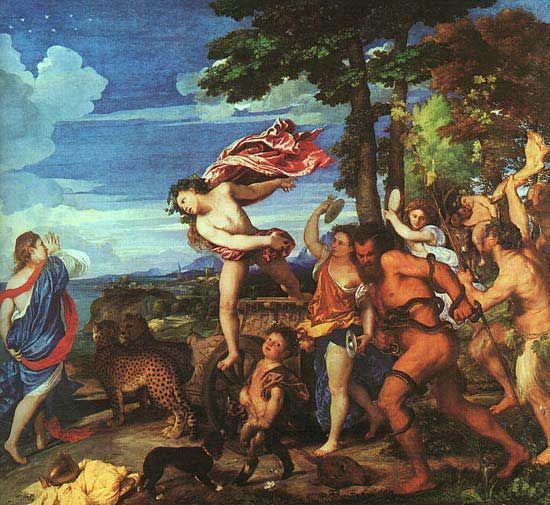
Titian Vecellio "Bacchus and Ariadne" (1520-1523) (National Gallery, London)
The "formation of unidentified flying objects" is considered to be a circle formed by eight lights in the sky at the top left.
From the Dictionary of Objects and Symbols in Art by James Hall:
"Classical iconography depicts Ariadne sleeping when god comes (...), but, according to Ovid, at that moment she was mourning her fate: therefore, Renaissance artists and later artists usually depict her awake. Bacchus grabbed Ariadne's precious crown and threw it into the sky. and it became a constellation. (...) Bacchus is depicted reaching the place riding on his chariot, sometimes with an entourage. He jumps to the ground or picks up Ariadne next to him. He takes off her crown, or it's already in the sky in the form of a sparkling circle of stars."
Thus, the circle of stars in the sky represents the crown of Ariadne, which in a mythological fairy tale turns into the constellation of the Northern Crown.

Tomb of Ptahhotep (circa 2400 BC) Saqqara, Egypt
Here you can see the silhouette of a "gray" alien. However, in the illustrated book entitled "All Egypt" (ed. Bonechi) we find much clearer and more detailed details of the same painted relief, and it turns out that this is a vase with a certain plant that was offered to the gods along with fruits and animals. In other places of Ptahhotep's tomb we find the same plant depicted.
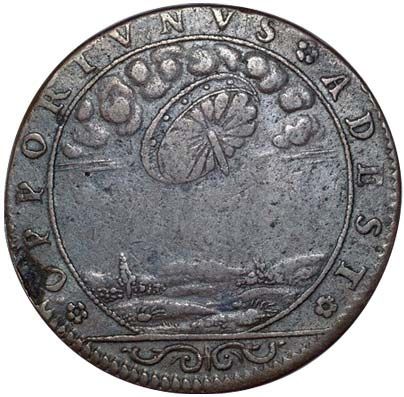
A token with the inscription "OPPORTUNUS ADEST"
As explained on a web page called Curieuses oeuvres d'art, this is a "token", probably minted in 1656. Many other tokens of this type can be viewed (and purchased) on the CGB Numismatic website. These tokens had no real value like coins, but they were so similar to coins that they fooled the stupidest.
Most likely, the scene depicted on it comes from Roman mythology. An object falling from the sky could be a shield of Jupiter (Ancil), protecting from storms and lightning (Ovid, Fasti, book III. The shield was a gift from Jupiter to the Roman king Numa Pompilius. God's promise was that Rome would be protected until the Romans took care of the sacred shield. The sentence "OPPORTUNUS ADEST" means something like "It is present in our time of need."
The Roman terracotta, kept in the British Museum, depicts Minerva (Pallas Athena), who helps Argos in the construction of his ship, the shield of the goddess of a similar shape is visible on the left.
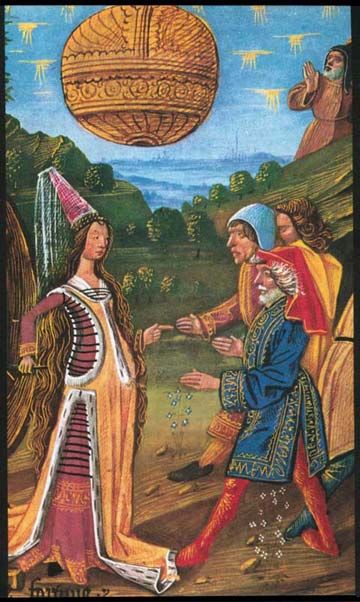
Illustration from the book "Le Livre Des Bonnes Moeurs" by Jacques Legrand, circa 1490 Chantilly, Conde Museum (ref 1338, 297 part 15 B 8)
A huge ball in the sky is usually mistaken for a UFO here.
The main character of the illustration is Fortune, spinning a Wheel and pointing at one of the people walking towards her. In the sky is a Globe, or Globe, which is often a symbol of Fortune, as James Hall explains in the Dictionary of Objects and Symbols in Art:
"There are two aspects of Fortune: 1) the changeable goddess of antiquity, dug up in the Renaissance, who unpredictably distributes her favors; 2) The medieval Lady Fortune turns her wheel. (...)
Its most common attribute, the GLOBE on which it sits or stands, was originally a symbol of instability, but for the Renaissance mentality it has become a symbol of the world to which it extends its dominance. (...)".

Tapestries "LA TENTURE DE LA VIE DE LA VIERGE", located in the Cathedral Church of Beaune (France).
Many UFO websites report the presence of mysterious objects in the sky on the first two tapestries, one with a Visiting scene and the other with a birth. These are two silhouettes that reminded many of the profile of classic "flying saucers" from science fiction of the 50s.
In several books devoted to tapestries, these objects are interpreted as a symbol of Cardinal Jean Rolain. The objects are located in the sky, above the image of a castle or a fortress city, as if denoting the ownership of these places by a symbol that defines the owner.

Lithograph "George Washington as a Mason", 1860
Many ufologists note a curious disc-shaped object in the left inner arch, which is depicted next to Jacob's Ladder.
Actually, Jacob's Ladder leads to heaven and, as in the usual biblical scene, opens up, showing the divine light.
The stages represent various "degrees" of primary education, and, in particular, in Freemasonry, they are defined by concepts borrowed from the Christian religion, such as Faith, Hope, Mercy, Justice, Prudence, Moderation and Fortitude. In this engraving, taken from the certificate of membership in the Masons, dated 1861, we also see three great symbolic pillars representing Wisdom, Strength and Beauty.

In many articles devoted to UFO sightings in the past, it is not uncommon to find a quote from the Genoese Case of 1608, often accompanied by this image.
This picture is from a series of slides created by GEOS (Groupe d'études des Objets Spatiaux de France) in the 1970s. They illustrate a document describing unique events:
At the beginning of August 1608, two great miracles occurred: a bloody rain that fell on Nice and other seaside towns (Provence) and the appearance in the sky of two men fighting each other several times, the latter being observed with great amazement for three days on the island of Martigues, five leagues from Marseille.
However, research of historical archives has shown that in the summer of 1608 in Genoa... nothing happened. And there are a number of other brochures, each of which contains a description of the amazing events that took place in different cities of Europe. And descriptions of "terrible miracles" at that time were a kind of literary genre.
Log in or register to post comments

